Monday, October 24, 2005

Georgia 23 Arkansas 20
The Dogs barely pull it off, thanks to excellent play by the defense. Gut check time upcoming in Jacksonville as David Shockley is not expected to play in theGeorgia-Florida game. |
Tuesday, October 18, 2005
A companion piece to the JACS article mentioned yesterday by the Aggravated Doc Surg is this one by the same author:Biliary Injury in Laparoscopic Surgery: Part 2. Changing the Culture of Cholecystectomy. The article goes into the different steps to take to ensure patient and physician safety, such as things to cover during informed consent. But the best part of the article is this:
In many industries there are stopping rules. These rules are applied in the face of dangerous conditions and are intended to stop a process before it continues into a zone of great risk. Good examples exist in aviation. If a flight is diverted to a secondary airport, it may be that the "ceiling" was too low at the primary airport. The process in making this decision is instructive. When the altimeter is at a specific value, the pilot must be able to see the runway clearly. If the runway cannot be seen the landing must be aborted. There is no leeway in this decision, no descending another 20 or 30 feet to take a peek. It is a hard and fast stopping rule for certain types of aircraft. The negative effects of diversion to a secondary airport are considered to be minor compared with the risk of a dangerous landing and its possible disastrous consequences. Note that the principle here is not merely avoidance of a crash. It is avoidance of entry into a danger zone in which the probability of a crash begins to rise to an unacceptable level. In a nuclear reactor, the core temperature is closely monitored and there are inviolate stopping rules that shut down the reactor when certain parameters are exceeded. Again, the principle is to halt before a zone of great danger is entered.(emphasis mine)
The application of a stopping rule to cholecystectomy for cholelithiasis is not as simple as that for a mechanical device such as an airplane or a nuclear power plant. The human body is much more complex than these mechanical systems; there are no "pop ups" on the video monitor during a laparoscopic cholecystectomy that signal the need to convert to open cholecystectomy. But what is important is the adoption of the mindset of the stopping rule in which safety is the chief consideration that governs decisions when danger is apparent. This is especially appropriate in a benign disease such as cholelithiasis, particularly because there are alternatives to pushing ahead with a difficult dissection.
When operative difficulty is encountered during laparoscopic cholecystectomy, the surgeon should pause to determine whether the operation should be continued laparoscopically. Local operative factors and operative experience of the surgeon are key considerations. Failure of progression of the dissection, anatomic disorientation, difficulty in visualization of the field, and inability of the laparoscopic equipment to carry out usual tasks such as grasping of the gallbladder or separation of tissues, are events that might be used as triggers of the stopping rule mentality in which subsequent actions are governed chiefly by considerations of safety. In most cases these events are indicators for conversion (or consultation). The negative effects of conversion are minor compared with the negative effect of a biliary injury, so like the airplane landing, it is best to back off when the zone of serious danger is entered rather than to determine if the procedure can be completed under dangerous conditions.....
Dr. Strasberg then carries this line of thinking to its' next level. What of the difficult open cholecystectomy?
The stopping rule mentality should not end after an incision has been made and applies equally to the difficult open cholecystectomy, in which the risk of completing an open cholecystectomy must be balanced against the risk of injury. Cholecystostomy is a good alternative in very difficult patients, and it is almost always possible. Partial cholecystectomy is another reasonable alternative in some cases of difficult open cholecystectomy. The worst injuries we have seen have come after conversion in patients with severe inflammation and have involved major vascular injuries and injuries to the bile ducts. Although the airplane analogies are useful, they can be taken only so far. Because of variation in operative experience, what constitutes the zone of serious danger may differ somewhat among surgeons.
In my opinion, the points made in the previous paragraphs cannot be emphasized too strongly and should be ingrained in all trainees, even though today these are in the "ought to be" category that will require a change in culture to achieve. There is an outlet when laparoscopic cholecystectomy is very difficult and potentially hazardous: conversion. There is an outlet when open cholecystectomy is very difficult and potentially hazardous: cholecystostomy. It is not appropriate to proceed laparoscopically when conditions are patently hazardous. For instance, it is inappropriate to attempt to stop bleeding laparoscopically when one cannot see well and there is a possibility that application of clips might also clip and injure bile ducts. In addition, the presence of clips on such a structure after operation, when it has been described that they have been used to arrest hemorrhage (and when other local operative conditions fall into the expected range for this procedure), is likely to convince most experts that the action was practice below the standard of care. The mind set of surgical trainees should be directed to methods that result in completing a large number of cholecystectomies safely, even if that means that fewer cholecystectomies are completed laparoscopically and that more converted laparoscopic procedures are completed by cholecystostomy.
(emphasis mine)
So if you are not a physician, not to mention a surgeon, what's the big deal? Part of it is the need to approach this procedure, as well as all others, with the idea of "safety first". When explaining the procedure and the possibility of conversion to patients I tell them that the goal is to remove the gallbladder in the safest way possible, and that the convenience of a laparoscopic procedure comes in a distant second.
Another concern is the volume of litigation related to this condition. From the first article:
There are no precise current statistics, but based on information received from risk management sources, it seems that biliary injury is by far the most common cause for litigation in gastrointestinal surgery. Claims arising from laparoscopic surgery represent 20% of all general surgery claims, and 50% of laparoscopic claims are for bile duct injury. In terms of indemnity (dollars paid out by insurers), the situation is even more serious because 33% of general surgery indemnity arises from laparoscopic procedures, and half of that is for biliary injury. So, about 15% of all general surgery indemnity is from biliary injuries. The percentage of biliary injuries litigated is very high. There are no current reliable statistics on the incidence of biliary injury. The latest high quality studies relate to operations performed in the last decade. Biliary injury has probably declined,2 but it seems still to be greater than during the period of open cholecystectomy.
And who knows? That could be your common bile duct with a titanium clip across it.
One of the concerns with surgical residents these days is that they often don't get enough exposure to open cholecystectomy. See here and here for more. |
Hosted for the first time by a patient blogger, Amy of Dibetes Mine. |
Monday, October 17, 2005
A post a few weeks in the making. 20-ish man in a motor vehicle collision. Open right elbow fracture and a severe degloving imjury to his calf.
After some debridement here is what I was left with:
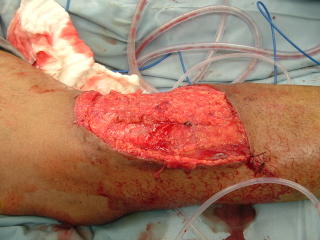
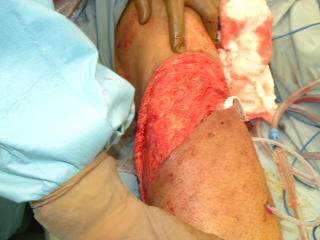
A bit more distal from the drain you see on the right was the extent of the degloving. I washed out the flap with about 3 liters of antibiotic containing saline. The drains were placed and the free edge sutured to the fasica with interrupted Vicryl sutures.
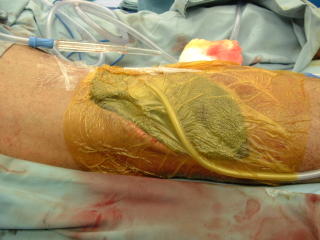
Over the open defect I placed a VAC dressing. The whole leg was then wrapped with an ACE bandage and he was placed in a knee immobilizer. After about 10 days of QOD trips to the OR for dressing changes under anesthesia it was finally time to graft. Here is what it looked like on that day:
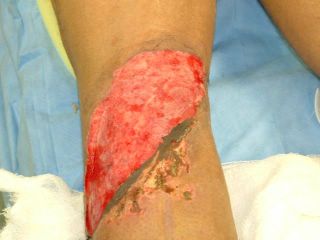
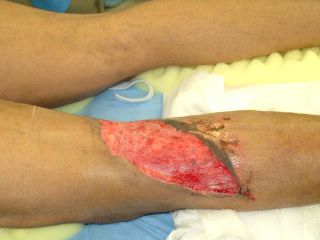
I debrided the inferior skin edge slightly and took the grafts from his poterior thigh. I also removed the JP drains. Applied another VAC over some Adaptic and let it sit for four days. Here is what it looked like:
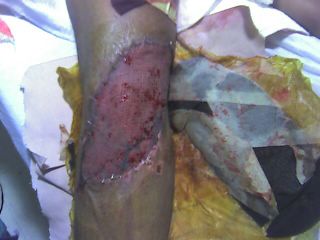
Close to a 100% take. He is out of the knee immmobilizer now and ambulating.
Labels: Tales from the Trauma Service
|Sunday, October 16, 2005

Georgia 34 Vanderbilt 17
This, combined with the Florida loss to LSU last night, puts the final battle of the SEC east at the World's Largest Outdoor Cocktail Party on October 29. |
Thursday, October 13, 2005
From Kevin MD a New York Times article making an inane comparison between medical billing and eating at a restaurant:
Suppose you walk into a restaurant," he said, "and you don't get a menu, you don't get any choice of what food you'll eat, they don't tell you what it is when they're serving it to you, they don't tell you what it's going to cost."What restaurant do you know of is forced, by law, to serve any hungry person that appears at their door?
"Then, weeks or months later, you get a bill that tells you all the food you ate and the drinks you had, some of which you remember and some you don't, and although you get the bill, you still can't figure out what you really owe," Dr. Brailer said.
How many restaurants must provide service to patrons that routinely engage in the old "dine and dash" again and again?
Would a more consumer driven system have the complexities described in the story? Methinks not. |
Wednesday, October 12, 2005
From yesterday's Wall Street Journal two letters in response to the story I discussed in yesterday's post. The first:
Your page-one article "A Doctor's Tale Shows Weaknesses in Medical Vetting" (Sept. 21) reminds all physicians of the two simple words describing the obstacle we face when disciplining a peer: hospital bylaws. These step-by-step rules on how things are to be done are ostensibly physician-written, but are in reality edited by hospital boards and their attorneys. They detail the committee meetings, the documentation, the practice and chart reviews, hearings, rebuttals and official notifications required in managing poor doctors. When followed to the letter, these rules hamstring the medical staff and delay suspension of the troublemaker while more patients suffer. If not precisely followed, which can easily happen in the emotional rush to protect patients, the accused physician's attorney charges the medical staff with violating its own bylaws. Then the bad apple cuts a deal and moves to another state, safe in knowing that it is illegal for the old hospital to tell the new hospital what happened. Then the malpractice begins anew.
So, which is better: the current system, or a different one where maybe overzealous doctors too quickly judge a colleague? I bet Dr. John Anderson King's patients know the answer.
Brantley Burns, M.D.
Tennessee Orthopedic Clinics
Knoxville, Tenn.
Now there is a fine balance between efficiency and due process. Examining the Dr. Poliner situation Dr. Rangel points out, quite rightly that peer review may be used as a blunt too against competitors. Ideally peer review would be fair and impartial, but not drawn out. Discipline should be meted out without fear of litigation. As I have posted before, outside of large cities peer review may be best served by outsourcing it.
The second:
As a board-certified orthopedic surgeon who chairs a large metropolitan hospital's clinical risk committee that supervises the clinical performance of its medical staff, I must say that the issues you raise aren't uncommon.
Dr. King's basic biographical information -- multiple practice locations crossing interstate lines, gaps in residency training and lack of board certification or eligibility -- are all red flags that should have prompted careful scrutiny of his practice qualification and credentials. Too often, hospital peer-review committees are left to deal with physicians practicing outside accepted standards whose initial credentialing process was "shepherded" by an overzealous administrator wanting to add new medical "product lines" or an established medical group eager to take on a new partner.
That willingness to expedite the due diligence process, rather than placing the burden of proof of clinical competence on the practitioner at the time of application to a hospital staff, sets the stage for the messy, and invariably litigious, denouement of suspension and expulsion from a medical staff, not to mention the harm done to a hospital's reputation or the community it serves.
In the case of Putnam County, W.Va., HCA Inc. didn't serve the interests of its patients well. Better no specialist in a community than a bad one.
Michael M. Katz, M.D.
Dallas
This is the "ounce of prevention is worth a pound of cure" letter. In a peer review situation the burden of proof is more equally divided between the committee and the physician. In a credentialing situation, even under "fair hearing" rules that most medical staff bylaws must follow, the burden of proof lies much more on the applicant. When I was on the credentials committee there were several situations where an applicant was asked to appear before the committee and explain litigation, gaps in training, or frequent moves. Sometimes the committee would be satisfied, other times we would not be and ask for additional documentation. A few times the applicant would "get the message" and either not provide the documentation, or withdraw the application.
Re-credentialing often times can fall into the same trap as peer review, depending on who sits on the committee. In fairness, I never felt pressured to pass along an applicant due to economic concerns of the hospital.
Additional views from Red State Moron and the Aggravated Doc Surg. |
In Atlanta yesterday, Georgia's tort reform faced its' first court test:Georgia's Supreme Court to Hear Tort Reform Case:
Opposing lawyers are preparing to face off over a state law that gives medical malpractice defendants the right to choose their home county as the site of a lawsuit if that's where the offense occurred.
Oral arguments in the closely watched case will be heard tomorrow before the Georgia Supreme Court.
At issue is the venue portion of a law passed by the Republican-led Legislature earlier this year. Supporters of the change said too many plaintiffs had been shopping to secure a friendly court.
The law also capped pain-and-suffering awards at 350-thousand dollars for malpractice cases, and set up incentives for patients to settle out of court. Other challenges to the law are expected in the months ahead.
At tomorrow's hearing, lawyers for a neurologist and his former practice group will argue that a lower court was correct when it ruled that a malpractice suit against the doctor should be tried in Bartow County, where the alleged malpractice occurred. The plaintiff had filed suit in Fulton County, which is known for high awards to plaintiffs in personal injury lawsuits.
Stay tuned..... |
Tuesday, October 11, 2005
In the "Personal Health" column yesterday:Net Benefits: Blogs offer a look at life on the front lines of medicine. Yours truly and several others are mentioned. The wider exposure of the medical blogosphere continues. |
From the Wall Street Journal:A Doctor's Tale Shows Weaknesses In Medical Vetting
John Anderson King joined the staff of Putnam General Hospital here in November 2002. In seven months, the orthopedic surgeon performed about 500 operations, mainly on patients' spines, arms and legs.Apparently this guy was quite the "Joe Izuzu":
During a routine review of the doctor's work, the hospital became concerned about some of his surgeries. In May 2003, Putnam, which is owned by the giant hospital chain HCA Inc., suspended his privileges, pending an internal investigation.
Edgar M. Dawson, a Los Angeles surgeon brought in for a peer review, called Dr. King a "snake-oil salesman" who was "not competent to practice medicine," according to a lawsuit Dr. King later filed against the surgeon in federal court in Los Angeles. In August 2003, before the hospital completed its inquiry, Dr. King resigned and turned in his West Virginia medical license.
Putnam and Dr. King's patients are still reeling from the surgeon's brief tenure. More than 100 malpractice suits have been filed against Dr. King and the hospital, according to state-court records in Putnam County, W.Va. Dozens of patients blame chronic back pain on allegedly unnecessary surgeries, court records show. None of the suits has been resolved.
One 90-year-old man died in 2003 from complications allegedly related to a back operation Dr. King is accused of recommending, despite the patient's age. A 38-year-old woman had her leg amputated in 2003 after an allegedly unsuccessful foot operation. State-court suits filed on behalf of the woman and the man's estate are pending. The suits accuse Dr. King of malpractice and the hospital of negligence in recruiting and employing him.
Many of the suits allege that Putnam overlooked warning signs, such as Dr. King's stop-and-start education, discrepancies in his résumé, and his involvement in past lawsuits, some of which he filed against employers when they tried to get rid of him
Described by patients as affable, Dr. King allegedly told some that he had once worked at the prestigious Cleveland Clinic. He hadn't. Patient James Cable of Charleston said that Dr. King told him he had competed in the Olympics in "kung fu." The doctor hasn't been in the Olympics, and kung fu isn't an Olympic event.Oh yes, his dragon style was far superior to the tiger style of the other competitors. The hospital was apparently blinded by the need to bring in patients and income:
Dr. King certainly got around:This is one of the problems that has haunted medicine for years," said Paul Schyve, senior vice president at the nonprofit Joint Commission on Accreditation of Healthcare Organizations. "Often the hospital is grateful the problem has ended without it having to take action for fear they may get sued.".......
......Financial pressures can drive hospitals to hire undistinguished doctors in highly profitable fields such as orthopedics. Putnam, a small 68-bed facility about 25 miles west of Charleston, has had an uneven financial record. It lost $630,574 on revenue of $65 million in 2001, the year before Dr. King arrived. The following year it turned a profit, only to fall into the red again in 2003.....
.......Putnam retained Comprehensive Healthcare Staffing of Norwalk, Conn., in October 2002 to recruit an orthopedic surgeon. After interviewing Dr. King on Oct. 9, 2002, the consulting firm sent a form to Putnam that included a handwritten note stating that his "hot button = $." Eight days later, Putnam signed Dr. King to a one-year contract with compensation of $420,000 and a signing bonus of $35,000. Comprehensive Healthcare said in a statement that it "received no indications of problems" with Dr. King's qualifications and that Putnam "retained the ultimate responsibility" for assessing him.
From 1990 through 1992, Dr. King trained as an obstetrics-and-gynecology resident at Albert Einstein Medical Center in Philadelphia. Putnam obtained a letter from Einstein dated Oct. 30, 2002, saying that he didn't complete the program, without explaining the circumstances, court records show.The article points out a JCAHO citation of the hospital's credentials committee and their poor oversight. Poor information also played a role:
In May 1993, he moved to an orthopedic residency at Hillcrest Health Center in Oklahoma City. Putnam received confirmation from Hillcrest that Dr. King completed the first two years of a four-year program. But court filings by Curry & Tolliver, the Charleston law firm representing many of the King patients, show that some documents Dr. King gave to Putnam during the hiring process list different dates or don't mention Hillcrest.
In fact, Hillcrest terminated Dr. King in March 1995, citing his marginal performance, according to a suit Dr. King filed in March 1997 in federal court in Oklahoma City. He accused the health center of poor training and fraudulent billing. To settle the suit, Hillcrest agreed to pay Dr. King $40,000 and allow him to resign, court records show.
HCA's Mr. Foust said that Putnam wasn't aware of the suit or settlement. He added that the letter from Hillcrest and a certificate indicating Dr. King had been at the Oklahoma City facility for two years outweighed any discrepancies with other documents. He noted that Dr. King's affiliation with Hillcrest was included on the AMA Web site. A spokeswoman for Hillcrest declined to comment, citing privacy issues.
From 1995 through 1997, Dr. King "performed the duties" of an orthopedic resident at Lincoln Medical and Mental Health Center in New York's Bronx borough, according to a certificate he provided to Putnam. But Harvey P. Insler, then chairman of orthopedic-residency training at Lincoln, said in an interview that Dr. King "was not an approved resident," meaning that he didn't get formal credit for the educational program.
Dr. Insler said that he raised questions with his board about giving Dr. King the certificate, but Lincoln decided it was appropriate. Despite the questions he said he raised, Dr. Insler provided Dr. King with a positive letter of recommendation. He said Putnam didn't ask him about the prospect before offering him a contract.
Putnam did contact Lincoln, which confirmed that Dr. King was there from October 1995 to March 1997, court records show. But in answer to the question of whether the residency had been completed, the Bronx center wrote "n/a," short for "not applicable." Even so, Mr. Foust said that Putnam relied on the certificate, the Insler recommendation and the AMA site.
In the late 1990s, Dr. King worked at Jackson County Hospital in Marianna, Fla., where he was arrested and charged with theft. The Florida hospital alleged that he removed two log books from the operating room, according to a January 1999 criminal complaint in Jackson Country Circuit Court. Dr. King pleaded not guilty and resolved the case without a conviction by paying a $225 fine and serving six months probation
Some key information about Dr. King available to potential patients wasn't accurate. Putnam General advertised him on its Web site in 2003 as a medical doctor in orthopedic surgery. But he doesn't have an M.D. Instead, he is a doctor of osteopathy, an alternative school of medicine that emphasizes the relationship of illness to the muscular-and-skeletal system. Osteopaths can function as full-fledged physicians and can do surgery.In my time on the credentials committee we faced issues, while not this severe, did cause concern. Physicians today are more mobile, but this guy seemed to be just a few steps ahead of the sheriff. One reason for the lack of information may be the ever-present threat of a lawsuit. Not only does the threat of a lawsuit impede the exchange of information but also discourages participation in peer review.
The physician-information Web site of the American Medical Association listed Dr. King as having graduated from the Meharry Medical College in Nashville. That, too, is wrong. He graduated from the University of New England College of Osteopathic Medicine in Biddeford, Maine. The AMA couldn't explain the discrepancy.
Dr. King isn't certified by one of the 24 national medical boards that offer credentials in specialty fields and are recognized by the American Board of Medical Specialties. About 90% of doctors have such a certification, but as is the case with some smaller hospitals, Putnam doesn't require it.
In doing its background check, Putnam consulted the AMA site and other physician databases, according to HCA's Mr. Foust. Dr. King provided documentation of his training and employment. But the industry practice is for hospitals to verify such information on their own. In the case of Dr. King, seemingly obvious red flags didn't stop Putnam from recruiting him.
The AMA listed Dr. King as having trained as a resident at five different institutions in three disparate specialties: orthopedic surgery, obstetrics and gynecology and anesthesiology. Records show that from 1985 through 1987, he dropped out of two residency programs in anesthesiology before completing a third. This pattern alone is unusual and could suggest a problem.
HCA's Mr. Foust says that Putnam didn't examine Dr. King's anesthesiology and obstetrics-and-gynecology training because the hospital wasn't hiring him to work in those areas.
Just a few months before Putnam hired Dr. King, the Joint Commission on Accreditation of Healthcare Organizations surveyed the hospital and concluded that its approach to checking doctors' credentials was "deficient." The hospital was required to make improvements, and the commission said it was in compliance by the following year, 2003.
After the anesthesiology residencies, he took a job in that field in 1989 at Walker Regional Medical Center in Jasper, Ala. The center soon suspended his privileges after he allegedly falsified patient records, according to copies of letters that an attorney for Dr. King wrote to Walker in June 1989. The letters have been filed in lawsuits brought on behalf of former patients. Dr. King's attorney, William N. Clark, declined to comment, citing client confidentiality.
Dr. King denied any unprofessional or unethical conduct at Walker but offered to resign if the suspension was rescinded, according to the letters. Walker then lifted the suspension, and he resigned.
Mr. Foust said Putnam wasn't aware of these events. A spokeswoman for Walker, which has been taken over by the Baptist Health System, said that it has no record of the dispute.
The problem here rests with the hospital's economic concerns trumping their mission of ensuring patient safety. |
Monday, October 10, 2005

Georgia 27 Tennessee 14
All the renditions of Rocky Top in the world couldn't stop Georgia from playing its' finest football this season. The Dogs are in control of their destiny as far as the SEC east is concerned. But as you can see, anything can happen:
 |
|





